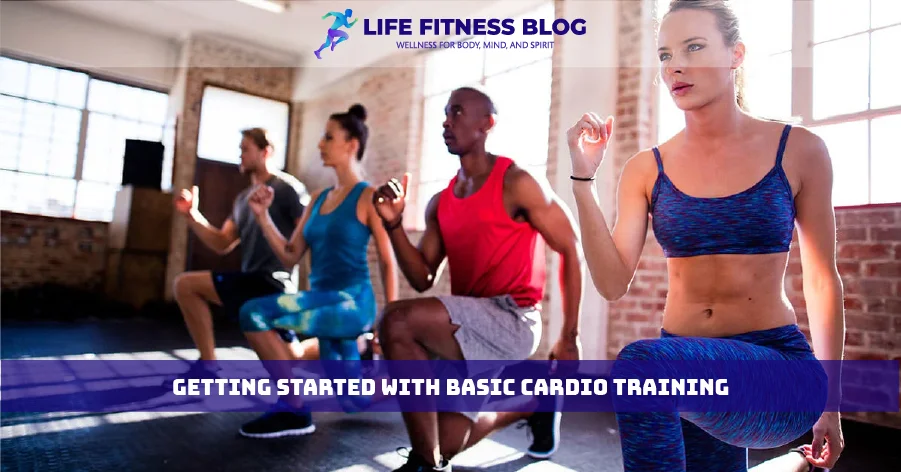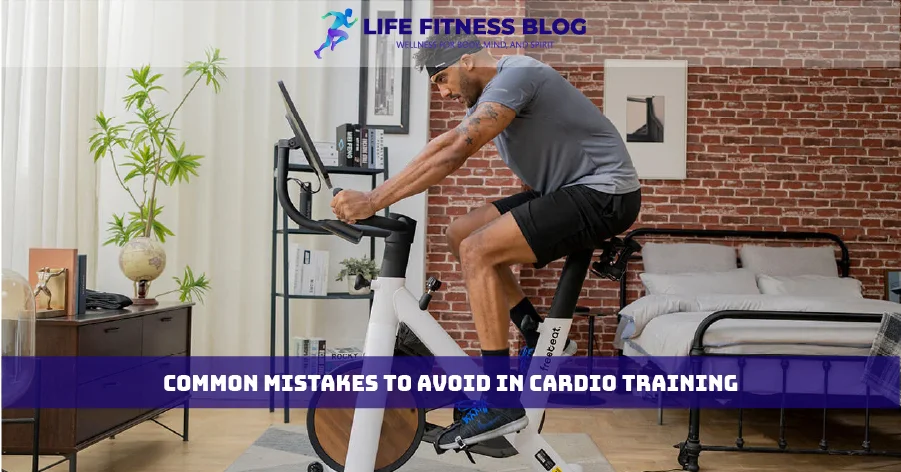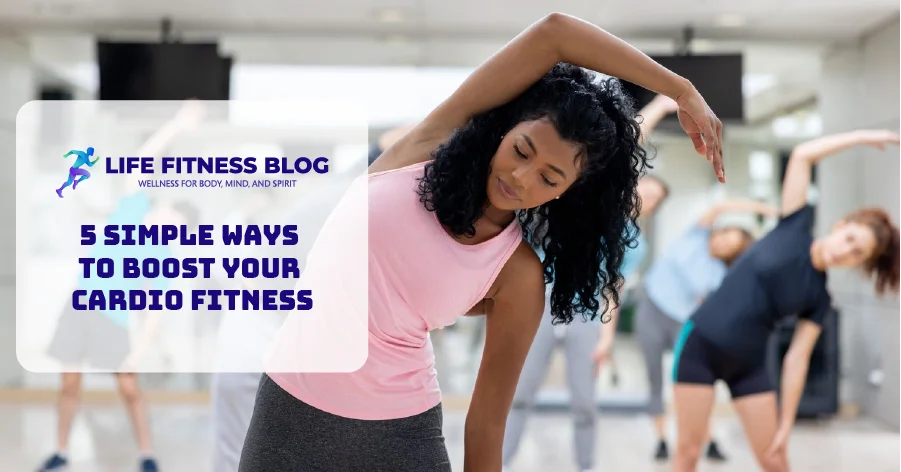Cardiovascular exercise, or “cardio,” is key to a healthy heart and better endurance. It’s great for your overall health. Whether you love working out or are just starting simple cardio routines can make a big difference. In this article, we’ll look at five easy ways to improve your cardio fitness and reach your fitness goals.
Getting better at cardio has many benefits. It makes your heart stronger, boosts stamina, and lowers the risk of serious health problems. By using the tips in this article, you’ll be on your way to better cardio fitness. You’ll enjoy a healthier, more energetic life.
Table of Contents
Understanding Cardiovascular Fitness and Its Benefits
Cardiovascular fitness is key to good health. It means your heart, lungs, and blood vessels work well together. This helps your muscles get the oxygen they need when you’re active.
Getting better at cardio fitness can greatly improve your heart health. It can also help you live longer and enjoy life more.
Impact on Overall Health and Longevity
Regular cardio workouts can lower your risk of heart disease and stroke. They make your heart stronger. This means it can pump blood more efficiently.
This reduces strain on your heart and blood vessels. It can lead to a longer, healthier life.
Key Components of Cardio Fitness
The main parts of cardio fitness are:
- Heart rate: Your heart rate shows how hard you’re working out. It shows how well your heart is doing.
- Oxygen uptake: This is your body’s ability to use oxygen when you’re active. It’s also known as VO2 max.
- Endurance: This is how long you can keep going during physical activity. It’s a big part of being fit.
Working on these areas through cardio exercise can boost your heart health. It can also increase your endurance and make life better.
Getting Started with Basic Cardio Training
Starting a cardiovascular exercise journey can feel overwhelming. But with the right help, you can lay a strong foundation for lasting fitness. Whether you want to boost your health, energy, or confidence, starting with basic cardio is a great step.
First, focus on proper warm-ups. Spend a few minutes on light stretching and gentle movements. This gets your body ready for the workout, lowers injury risk, and makes exercising more fun. As you get fitter, slowly increase the intensity and time of your workouts. Let your body adjust at its own pace.
- Set realistic, achievable goals: Create specific, measurable targets that match your fitness dreams and timeline. This keeps you motivated and lets you see your progress.
- Start with low-intensity exercises: Begin with brisk walking, light jogging, or swimming. Then, as you get stronger, move on to harder workouts.
- Incorporate interval training: Mix high-intensity bursts with lower intensity or rest. This makes your cardio routine more effective.
- Fuel your body properly: Eat a balanced, nutrient-rich diet to support your workouts and overall health.
- Listen to your body: Watch for any discomfort or signs of overtraining. Adjust your routine to avoid injury and keep making progress.
Consistency and patience are key to good cardiovascular fitness. By following these tips, you’ll be on your way to enjoying the many benefits of cardiovascular exercise. You’ll see improvements in fitness motivation and overall exercise tips.

High-Intensity Interval Training for Maximum Results
If you want to boost your cardio fitness, try high-intensity interval training (HIIT). This workout is quick and can greatly improve your endurance and heart health.
HIIT Workout Structure
HIIT mixes short, intense exercises with rest periods. This pattern pushes your body hard and then lets it recover. This way, you get better faster.
Sample HIIT Routines for Beginners
- Begin with a basic HIIT routine: do 30 seconds of intense burpees followed by 60 seconds of walking. Repeat this 5-10 times.
- Try a bike-based HIIT: cycle at high resistance for 1 minute, then at low resistance for 1 minute. Do this for 10-15 minutes.
- Use bodyweight exercises like jumping jacks and mountain climbers in a HIIT circuit. Switch between exercises and rest periods.
Recovery and Rest Periods
Rest is key in HIIT. It’s as important as the intense parts. Make sure to rest enough between hard efforts. Aim for a 1:1 or 1:2 work-to-rest ratio.
Adding HIIT to your routine can greatly improve your fitness. It’s a quick way to boost your high-intensity interval training, endurance training, and overall exercise tips. It’s a dynamic and effective workout.
Low-Impact Cardio Options for Joint Health
If you want to increase your cardiovascular exercise without harming your joints, there are good choices. These activities help improve your fitness motivation. They are also great for people with joint problems or recovering from injuries.
Aquatic Exercises
Swimming and other water activities are excellent for low-impact cardio. The water supports your body, easing the pressure on your joints. You can try swimming laps or join water aerobics for a fun workout.
Elliptical Training
The elliptical machine is a low-impact, full-body cardiovascular exercise. It simulates running or walking without a hard impact. Its smooth motion is easier on your joints, making it a good option for those looking for a low-impact cardio alternative.
Stationary Cycling
Stationary cycling, on a regular or recumbent bike, is another low-impact choice. It keeps your joints off the ground, helping to boost your heart rate without the joint stress. This is especially good for your knees, ankles, and hips.
Adding these low-impact cardio options to your routine can keep you active and healthy. It also helps protect your joints and boosts your fitness motivation.
5 Simple Ways to Boost Your Cardio Fitness
Improving your heart health doesn’t need to be hard. Adding a few outdoor cardio activities to your day can really help. Here are five easy ways to get your heart rate up and boost your fitness.
Walking and Jogging Techniques
Walking and jogging are great for your heart and don’t hurt your joints. To get the most out of them, keep your back straight, engage your core, and slowly increase your speed and time. Try interval training by switching between fast walking and jogging to make it more effective.
Swimming and Water Exercises
Swimming and water exercises are cool and easy on your body. They’re perfect for improving your heart health. You can swim laps, do water aerobics, or try interval training in the water. All of these activities can help you get fitter and feel better.
Cycling Strategies
Cycling is a great way to work out your legs and heart. You can cycle on a bike at home or outside. Try different types of rides like hills, sprints, and steady cycling to keep things interesting. Cycling regularly can really improve your fitness and endurance.
| Outdoor Cardio Activity | Benefits | Tips for Maximizing Results |
|---|---|---|
| Walking and Jogging | Improved endurance, cardiovascular health, and joint mobility | Maintain proper posture, gradually increase intensity, and incorporate interval training |
| Swimming and Water Exercises | Low-impact workout, enhanced cardiovascular fitness, and full-body strengthening | Experiment with different water-based activities, such as laps, aerobics, and interval training |
| Cycling | Leg muscle development, cardiovascular endurance, and improved exercise performance | Vary your cycling techniques, including hill climbs, sprints, and steady-state rides |
Adding these outdoor activities to your routine can really boost your heart health. You’ll see better exercise performance and enjoy the benefits of increased endurance.
Indoor Cardio Workouts for Any Weather
When the weather outside isn’t cooperating, it’s essential to have a plan B for your cardiovascular exercise routine. Indoor cardio workouts offer a convenient and effective way to maintain your fitness level, regardless of the conditions beyond your door. Whether you’re faced with heavy rain, blistering heat, or a sudden snowstorm, these indoor options can help you stay motivated and on track with your fitness goals.
One of the most popular indoor cardio choices is the treadmill. Varying the incline and speed can provide a challenging and customizable workout, allowing you to mimic the experience of running or walking outdoors. For those seeking a more intense session, high-intensity interval training (HIIT) on the treadmill can be a game-changer, as it alternates periods of all-out effort with active recovery.
- Stair climbing, either on a stair-stepper machine or by using the stairs in your home or office building, is another excellent indoor cardio workout that targets your lower body and cardiovascular system.
- Home-based circuit training, incorporating bodyweight exercises like burpees, jumping jacks, and mountain climbers, can also elevate your heart rate and improve your overall cardiovascular exercise.
The key to maintaining your fitness motivation during indoor cardio sessions is to find activities you genuinely enjoy. Experiment with different options, create playlists to keep you energized and celebrate your progress along the way. With a little creativity and the right mindset, you can conquer your indoor cardio workouts and emerge stronger, healthier, and more resilient than ever before.

Combining Strength Training with Cardio Exercise
To get the best heart health, you need a mix of endurance and strength workouts. This blend boosts your health and fitness levels.
Circuit Training Benefits
Circuit training is a great way to mix strength and cardio. It’s a fast-paced routine that moves between exercises for different muscles. This boosts your heart health and strengthens your muscles.
Balancing Different Types of Exercise
It’s key to balance strength and cardio in your workouts. Set aside specific days for each. This variety helps improve your strength and heart health.
- Do strength training, like weightlifting, 2-3 times a week.
- Use 2-3 days for cardio, like running or cycling.
- Take rest days to avoid injury and burnout.
Combining strength and cardio workouts makes your fitness routine better. Always listen to your body and adjust your schedule for the best results.
Tracking Progress and Setting Achievable Goals
Starting a fitness motivation journey needs dedication and the skill to track progress and set goals. For cardiovascular exercise, seeing your growth can really motivate you to keep going.
Heart rate monitoring is a great way to track your exercise tips. You can use a fitness tracker or a smartphone app. This lets you see how hard you’re working and if your training is paying off.
- Know your target heart rate zones to stay in a healthy and effective range.
- Look at your heart rate to see how far you’ve come, like better endurance and quicker recovery.
- Do regular fitness tests, like timed mile runs or step tests, to measure your heart health.
Setting achievable goals is key to staying motivated and seeing real results. First, check where you are now and then set goals you can reach.
| Goal Type | Example |
|---|---|
| Short-term | Increase your weekly step count by 10% |
| Medium-term | Complete a 5K run in under 30 minutes |
| Long-term | Improve your VO2 max by 15% over the next six months |
The secret to success is setting goals that are clear, have a deadline, and are just a bit challenging. Celebrate your wins and don’t hesitate to change your goals as you get stronger.
Common Mistakes to Avoid in Cardio Training
Starting a cardio workout plan is exciting. It’s a step towards better health and fitness. But, it’s important to watch out for common mistakes that can slow you down or cause injury. Knowing and avoiding these errors will help you stay safe and get the most out of your cardiovascular exercise.
Overtraining Signs and Prevention
One big challenge in endurance training is avoiding overtraining. Pushing too hard without enough rest can make you tired, burn out, and even perform worse. Signs of overtraining include constant muscle pain, less hunger, trouble sleeping, and a weaker immune system.
To avoid overtraining, listen to your body and take rest days. Slowly increase how hard and long your exercise tips are. Letting your body recover and get stronger is key to lasting progress.
Proper Form and Technique
Keeping the right form and technique during cardio is crucial. Bad form can make your workouts less effective and raise injury risks. Whether you’re walking, jogging, swimming, or cycling, focus on your posture, joint alignment, and how you move.
- Engage your core to keep good posture and lower back strain.
- Avoid overstriding or excessive heel striking, which can harm your knees or ankles.
- Keep your movements smooth and fluid when swimming or cycling to get the most out of it and avoid muscle strain.
By focusing on the right form and technique, you’ll get more out of your cardiovascular exercise. You’ll also lower the chance of injuries that could stop your progress.

Conclusion
Incorporating simple ways to boost your cardio fitness can greatly improve your heart health. Regular endurance training, like walking or jogging, can make your heart stronger. This can also help you live longer.
Finding activities you enjoy is key. This makes sticking to a fitness routine easier. Try different things and keep your workouts interesting. Small steps can lead to big improvements in your fitness.
Start your journey, set goals, and celebrate your successes. Your heart will thank you. You’ll feel more energetic, sleep better, and feel overall well. Begin your path to a healthier, more active life today.
Also Read:
FAQs
How can I improve my cardiovascular health through exercise?
Incorporate regular cardio workouts like running, swimming, cycling, or brisk walking into your routine. Aim for at least 150 minutes of moderate-intensity exercise per week.
What are some low-impact cardio exercises suitable for beginners?
Beginners can start with low-impact activities like swimming, water aerobics, or cycling. These exercises are gentle on the joints and can help build endurance gradually.
How can I make my cardio workouts more enjoyable?
Find activities you enjoy, listen to music or podcasts while working out, and consider working out with a friend or joining a fitness class.
How often should I do cardio workouts?
Aim for at least 3-4 days of cardio per week, but listen to your body and adjust the frequency as needed.
What are some tips for staying motivated to do cardio?
Set realistic goals, track your progress, find a workout buddy, and reward yourself for achieving milestones.




